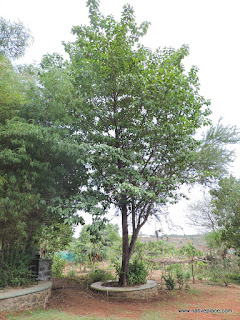Kadamb (Anthocephalus Cadamba/कदंब) or
The Common Bur Flower is a large, handsome, umbrella shaped tree with
branches arranged in whorls around the central trunk. It is evergreen, fast growing
and has a graceful appearance. It produces
unique globular shaped flowers coloured a striking yellow to orange.
In India the tree is mainly associated with
Lord Krishna and stories about him and his gopis prancing about in the forests
of Brindavan among the Kadamba groves abound. This tree is also
closely associated with the Mother Goddess (often referred as Kadambavana
vasini) "She Who Resides in the Forest of Kadamba
Trees."
We
have a lovely specimen of this legendary tree in the Native Place Garden that we planted
about 7 or 8 years ago having been intrigued by the lore of its beauty as well
as its mythological and ecological associations. You can enjoy its beauty and shade throughout
the year but in the month of May the tree offers a special sensory experience when
it flowers in profusion, showing off its quaint yet beautiful flowers that
attract a host of bees and exude a heady perfume. And as the flowers drop one
finds the curious golden globes scattered all around the tree waiting to dry
off and release thousands of little seeds.
We
have built a low wall all around our Kadamba tree. A silent invitation to you
to come sit under this tree and enjoy the ambience it conjures.
The
Kadamba Anthocephalus Cadamba is often mixed up with the Kaim – Mitragaayne
parviflora a tree that is dominant in
the forests of Brindavan. Both spcies produce globular blossoms but the Kaim’s
flowers are not as striking to look at.
They also differ greatly in canopy and leaf shape. Where the Kadamba has a
straight bole and branches arranged in upward reaching whorls the Kaim has a
fairly meandering trunk.
i
came across the Kaim in the “Trees of Delhi” by Pradeep Kishen. Pradeep sheds
light on this confusion/ puzzle on page 149 –
where he informs us that the REAL Krishna Kadamb of Brindavan is Neelamarcia cadamba ‘Kaim’ not Anthocephalus Cadamba ‘Kadamba’ which
is unique to moist forests in the
NE of India and would not survive
unaided in the hot dry Brindavan
area. Kaim on the other hand is not only
native to the remnant Brindavan forests but is their dominant tree. But in the
Brindavan region the Kaim is called kadamb
J
no wonder the confusion !
Oh well !!! Our Kadamba may not
bring to mind the visual of Krishna playing his flute any more but it remains
the tree closely associated with the Mother Goddess - Kadambavana vasini "She Who Resides in the grove of Kadamba Trees."
The tree is said to be vanishing from Indian forests
and needs to be planted and celebrated once more for it its beauty,
functionality and usefulness.
Some Uses
This
beautiful tree is also known for its medicinal virtues. The tree has
astringent & antipyretic properties. It is believed to have cure
for ulcers, digestive ailments, diarrhoea, expectorant, fever, vomiting
etc.
A yellow dye is obtained from the root bark. Kadamb flowers are an important raw material in the production of attar, Indian perfume with Sandalwood (Santalum Album). The tree is grown along avenues, roadsides and villages for shade. The fresh leaves are sometimes used as plates.
A yellow dye is obtained from the root bark. Kadamb flowers are an important raw material in the production of attar, Indian perfume with Sandalwood (Santalum Album). The tree is grown along avenues, roadsides and villages for shade. The fresh leaves are sometimes used as plates.
In Permaculture
The Kadamba is suitable for reforestation programs. It
sheds large amounts of leaf and non-leaf litter which on decomposition
improves the physical and chemical properties of soil.
Cultural aspects
It
is common belief among the natives of many villages in the state
Chhattisgarh that plantation of Kadamb tree near to lakes and ponds,
brings happiness and prosperity in their life.


No comments:
Post a Comment